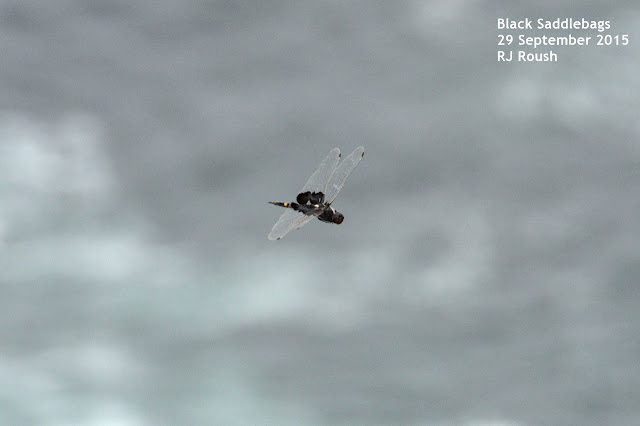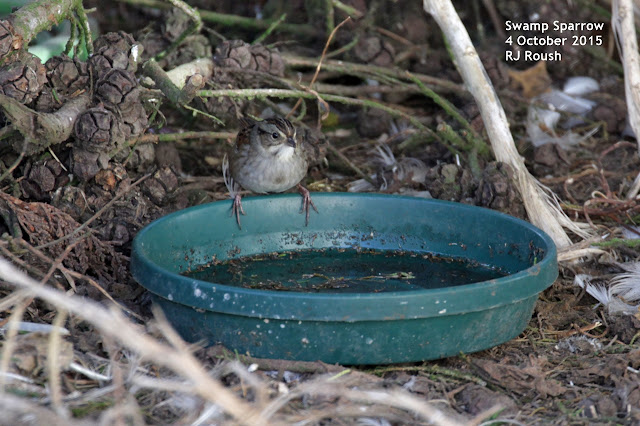We just completed our week long 24th annual
Farallonathon and despite our relatively slow September, we made a respectable
final score compared to the other years. For all of those who are new to this,
the Farallonathon is the Southeast Farallon Island's version of Point Blue's
Bird-a-thon fundraiser. The Farallonathon was started in 1992 by Peter Pyle in
order to highlight the uniqueness of the island and the diversity of the
species it attracts. That being said, we do things slightly differently: our count
lasts an entire week instead of just 24 hours, and we count all species
including mammals, dragonflies, butterflies, sharks, and of course, birds. Each
species gets one point, unless it needs to be reviewed by the California Bird Records Committee (CBRC), then it gets five
points. For first island records of a species we are awarded ten points, and
for each shark attack we get an additional five points.
Day 1 - We started off with typical Fall weather—fairly clear skies, visibility almost to the mainland, a light wind out of the NW. We had our usual 3 species of sulids: Northern Gannet, Brown Booby (15 individuals!), and a Blue-footed Booby for a total of 15 points, since they're all CBRC birds. On the evening sea watch, two of our birders saw a Manx Shearwater fly by, yet another CBRC bird.
A few other noteworthy birds were the two Dickcissels, one of
which we banded,
a Sharp-shinned Hawk,
a Magnolia Warbler,
and two Rock Pigeons, which may seem rather mundane but this introduced species rarely shows up on SEFI in the fall.
There were also a host of other birds that we see here more commonly such as Lesser Goldfinches, Fox Sparrows, Golden-crowned Sparrows, Black Phoebes, an Anna's Hummingbird, Audubon's Warblers, Western Wood-Pewee and several Burrowing Owls.
We also had our only non-marine mammal for the entire week, a
red bat which had been hanging around for a few days in a bush (see previous
blog entry) and a Black Saddlebags. All this gave us 90 points
for our first day!
Day 2 – The weather stayed the same, but we had a few more birds find their way to the island. Two Eared Grebes were seen floating near the island early in the morning and a Black-footed Albatross graced us with it's presence (though far off) on an afternoon seawatch. On land we had a few new species including three Swainson's Thrushes, a Chestnut-sided Warbler, a Clay-colored Sparrow and a Lapland Longspur.
We also saw two shark attacks from the lighthouse giving us an extra ten points, bringing our total to 110.
Day 3 – The winds continued to be light from the northwest
with visibility to the mainland. We had a few different species of warblers
show up as well as two more shark attacks. For warblers, we found
Townsend's, Western Palm, Blackpoll, a Common Yellowthroat and banded a Nashville.
In addition, we found a Say's Phoebe, a Pine Siskin and a Northern Harrier that was spotted flying over the terrace. From the lighthouse we spotted two Blue Whales and a pod of 30 Common Dolphins adding two more points for a total of 133.
Day 4 – Today was a bit slower than the rest due mostly to
the wind picking up to 15kts (17mph). The only points we scored were for the 8
new birds that turned up: Pacific Loon, American Wigeon and South Polar Skua on
sea watches and a Mourning Dove, Northern Flickers (yellow-shafted and intergrade), two Western Meadowlarks and two Brewer's Blackbirds on land. With the additional eight points we were up to 141 at the end of day 4.
Day 5 – With a gale in the forecast for later in the day and
our attention focused on a boat landing in the morning, we did not expect to
find many birds or other species around the island. The winds peaked around
40kts (46 mph) and the swell got up to 15 feet or more. That didn't discourage
us from finding a few new birds. A Grasshopper Sparrow was found taking shelter
from the wind in a rock pile and a Short-eared Owl was found doing the same
under a bush of tree mallow (Lavatera arborea) and later in a Pigeon Guillemot
crevice.
During the evening seawatch one of our interns spotted a Red-breasted Merganser flying close past the island which is one of the earliest records for this species.
Day 6 – The winds calmed down to almost nothing from the
night before and began to shift direction from the usual NW to a more favorable
migrant bird forecast of S to SW. The morning started off with a Swamp Sparrow
at our bird bath outside the living room window
which inspired us to start searching immediately. Early in the day we heard a Wood Peewee call that was not quite right for Western. We caught it and measured it out as an Eastern and upon release it started making the perfect Eastern Wood Peewee call making it a five point CBRC bird.
A group of 16 Elegant Terns were heard and then seen foraging off East Landing for the majority of the day; a Belted Kingfisher was found over at North Landing; and a Cackling Goose made it's way into Garbage Gulch.
All that plus a shark sighting and two new dragonflies (a variegated meadowhawk and a 12-spotted skimmer) put our total at 171 points on our second to last day.
Day 7 – The weather forecast predicted the wind to continue
out of the south, and for a high overcast (optimal migration conditions for the
Farallones), so all of us prepared for a
big wave of birds to arrive. Although the mega-wave did not materialize, we did
have a few new arrivals. Highlights for the day included the Brewer's Sparrow
we found in one of our mist nets,
a Flesh-footed Shearwater flyby, two
Parasitic Jaegers, the first Mew Gull of the season two Farallon Arboreal
Salamanders found under a maintenance panel, and a single Painted Lady bringing
our total for the week to 179 points.
We had an exciting and eclectic mix of birds this year and a
good amount of shark action (4 sightings and 4 attacks) which really helped our
score. For a little bit of reference we finished just above the 174 point
average this year, putting us in 10th place overall since the beginning
in 1992. The highest scoring year was 2001 with 240 points and the lowest was
2008 with only 129 points.
If you enjoy reading our blog and would like to contribute money to our Farallonathon to support current and future research projects, please click on the link to contribute:
http://2015birdathon.kintera.org/faf/search/searchTeamPart.asp?ievent=1144989&team=6532951
If you enjoy reading our blog and would like to contribute money to our Farallonathon to support current and future research projects, please click on the link to contribute:
http://2015birdathon.kintera.org/faf/search/searchTeamPart.asp?ievent=1144989&team=6532951

















1 comment:
I love how you say "We had our usual 3 species of sulids"...ha ha USUAL, yeah. I wish I was back out there with you all! <3
Post a Comment